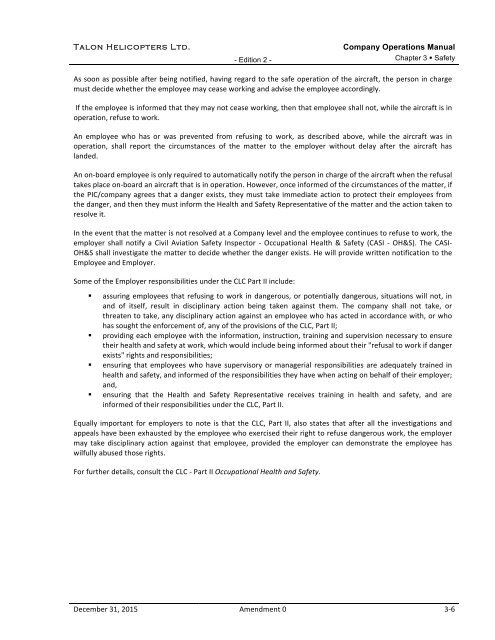Talon Helicopters Ltd COM Edition 2 Amend 0 submission 3 TC Stamped
Create successful ePaper yourself
Turn your PDF publications into a flip-book with our unique Google optimized e-Paper software.
<strong>Talon</strong> <strong>Helicopters</strong> <strong>Ltd</strong>.<br />
- <strong>Edition</strong> 2 -<br />
Company Operations Manual<br />
Chapter 3 § Safety<br />
As soon as possible after being notified, having regard to the safe operation of the aircraft, the person in charge<br />
must decide whether the employee may cease working and advise the employee accordingly.<br />
If the employee is informed that they may not cease working, then that employee shall not, while the aircraft is in<br />
operation, refuse to work.<br />
An employee who has or was prevented from refusing to work, as described above, while the aircraft was in<br />
operation, shall report the circumstances of the matter to the employer without delay after the aircraft has<br />
landed.<br />
An on-board employee is only required to automatically notify the person in charge of the aircraft when the refusal<br />
takes place on-board an aircraft that is in operation. However, once informed of the circumstances of the matter, if<br />
the PIC/company agrees that a danger exists, they must take immediate action to protect their employees from<br />
the danger, and then they must inform the Health and Safety Representative of the matter and the action taken to<br />
resolve it.<br />
In the event that the matter is not resolved at a Company level and the employee continues to refuse to work, the<br />
employer shall notify a Civil Aviation Safety Inspector - Occupational Health & Safety (CASI - OH&S). The CASI-<br />
OH&S shall investigate the matter to decide whether the danger exists. He will provide written notification to the<br />
Employee and Employer.<br />
Some of the Employer responsibilities under the CLC Part II include:<br />
§ assuring employees that refusing to work in dangerous, or potentially dangerous, situations will not, in<br />
and of itself, result in disciplinary action being taken against them. The company shall not take, or<br />
threaten to take, any disciplinary action against an employee who has acted in accordance with, or who<br />
has sought the enforcement of, any of the provisions of the CLC, Part II;<br />
§ providing each employee with the information, instruction, training and supervision necessary to ensure<br />
their health and safety at work, which would include being informed about their "refusal to work if danger<br />
exists" rights and responsibilities;<br />
§ ensuring that employees who have supervisory or managerial responsibilities are adequately trained in<br />
health and safety, and informed of the responsibilities they have when acting on behalf of their employer;<br />
and,<br />
§ ensuring that the Health and Safety Representative receives training in health and safety, and are<br />
informed of their responsibilities under the CLC, Part II.<br />
Equally important for employers to note is that the CLC, Part II, also states that after all the investigations and<br />
appeals have been exhausted by the employee who exercised their right to refuse dangerous work, the employer<br />
may take disciplinary action against that employee, provided the employer can demonstrate the employee has<br />
wilfully abused those rights.<br />
For further details, consult the CLC - Part II Occupational Health and Safety.<br />
December 31, 2015 <strong>Amend</strong>ment 0 3-6


